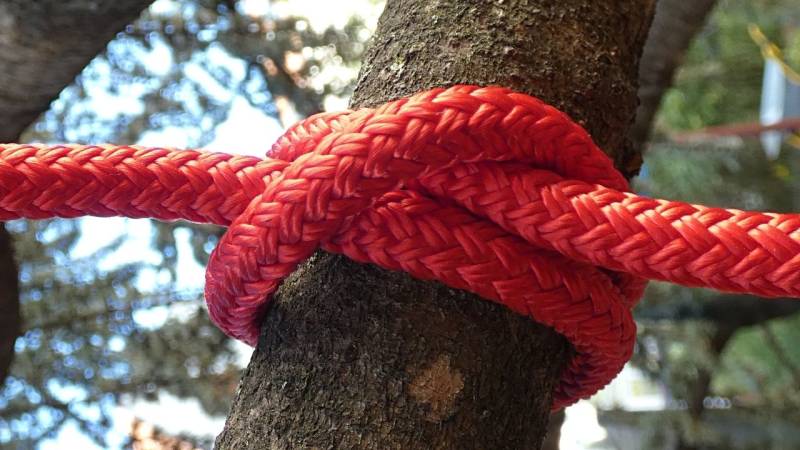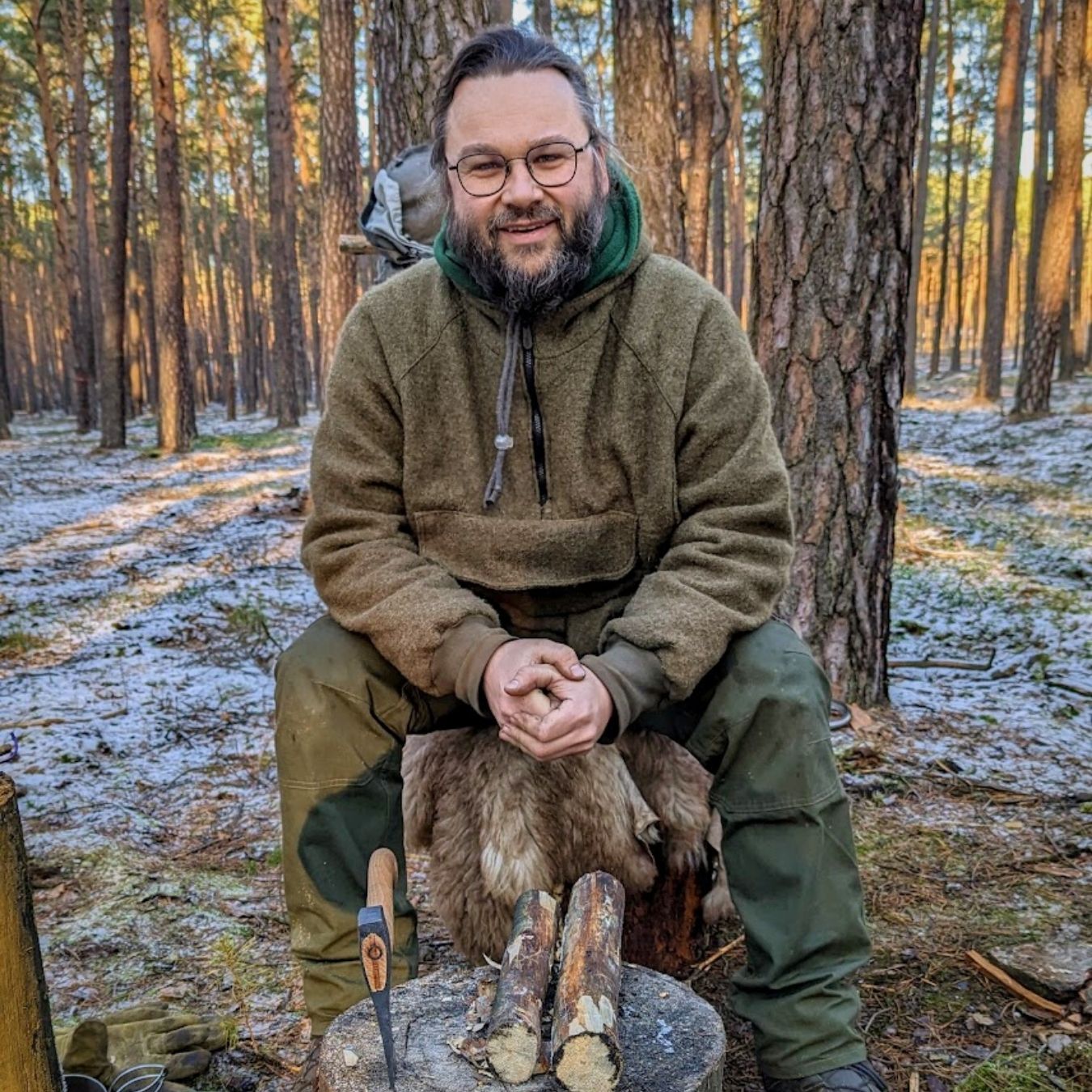
tying knots
Verb
Meaning
Tying knots is an essential skill in the world of survival, bushcraft, and outdoor activities. It involves creating secure and reliable connections between ropes or cords, allowing you to build shelters, secure gear, or even rescue someone in need. Knowing how to tie knots properly can make a significant difference in your ability to navigate and thrive in the wilderness. Whether you're camping, hiking, or engaging in any outdoor adventure, understanding different types of knots and their applications is crucial. From the versatile and widely used square knot to the specialized and intricate bowline, mastering knot tying is a fundamental skill for any outdoor enthusiast.

Examples
„I love tying knots because it allows me to secure my shelter and gear in the wilderness. It's essential to know how to tie different knots for various purposes.“
„When I went camping with my friends, I showed them how to tie a bowline knot to secure the tarp over our campfire. It held up perfectly throughout the night.“
„During a survival training course, our instructor taught us the importance of knowing how to tie a figure-eight knot. It's a strong and reliable knot that can be used for climbing and rappelling.“
„When I was hiking in the mountains, I had to quickly tie a clove hitch knot to secure my backpack to a tree branch while I took a break. It kept my bag off the ground and protected it from animals.“
„One of the most useful knots I've learned is the trucker's hitch. It's a versatile knot that can be used to tighten and secure loads, such as when I need to secure my canoe to the roof of my car.“
„Tying knots is not only practical but also a fun and satisfying skill to master. It's like solving a puzzle and knowing that you have the knowledge to secure and adapt in any outdoor situation.“
Origin
The word "tying knots" originates from the Old English word "cnotta," which means "knot." The practice of tying knots has been around for centuries and can be traced back to ancient civilizations such as the Egyptians and the Greeks.
Knot tying has evolved over time and has been used for various purposes, including sailing, fishing, camping, and survival. It has been an essential skill for seafarers, allowing them to secure ropes and rigging, while also providing a means of communication through different knot patterns.
In the realm of survival and bushcraft, tying knots is crucial for creating shelters, setting traps, securing gear, and performing various tasks in the wilderness. Different types of knots serve different purposes, such as the clove hitch for attaching ropes to trees or the bowline knot for creating a secure loop.
Today, knot tying is not only a practical skill but also a popular hobby and a form of art. Many people enjoy learning and mastering different knot techniques, exploring their intricate designs and patterns.
Synonyms
Knotting, Securing, Fastening, Binding, Hitching, Lashing, Roping, Tethering
Antonyms
Untying knots, Loosening knots, Releasing knots, Undoing knots, Unfastening knots, Unbinding knots, Untangling knots, Unraveling knots
Relatives
Knot tying, Rope knots, Knotting techniques, Knotting skills, Knotting tools, Knotting tutorials, Knotting practice, Knotting methods
Historical and cultural importance
Tying knots has a rich historical and cultural significance that spans across various civilizations and time periods. The art of knot tying dates back thousands of years and has been an essential skill for survival, navigation, and craftsmanship.
In ancient times, knots were used by sailors to secure their ships, rigging, and sails. Different types of knots were developed to serve specific purposes, such as the square knot for joining two ropes together or the clove hitch for fastening objects to a pole or post.
Throughout history, knots have also played a crucial role in various cultural practices and traditions. For example, in many Native American tribes, intricate knot designs were woven into baskets and textiles, symbolizing different aspects of their culture and beliefs.
In the world of bushcraft and survival, knot tying is an essential skill that allows you to create shelter, secure gear, and even catch food. Knowing how to tie knots properly can make a significant difference in your ability to navigate through challenging terrain and survive in the wilderness.
Today, knot tying continues to be a valuable skill in many fields, including sailing, rock climbing, camping, and even in everyday life. From tying shoelaces to securing loads on vehicles, the ability to tie knots effectively is a practical skill that everyone can benefit from.
So, whether you're an outdoor enthusiast, a craftsman, or simply someone who wants to be prepared for any situation, learning the art of tying knots is a valuable and fascinating endeavor.
More information about the term tying knots
Tying Knots: Essential Skills for Survival
When it comes to survival in the wilderness, one skill that is absolutely essential is the ability to tie knots. Whether you're setting up a shelter, securing gear, or creating tools, knowing how to tie knots properly can make all the difference in a survival situation. In this article, I'll introduce you to some of the most important knots every survivalist should know.
The Square Knot
The square knot, also known as the reef knot, is a basic knot that is used to join two ropes of equal diameter. It's simple to tie and untie, making it a versatile knot for various applications. Whether you're bundling firewood, creating a makeshift clothesline, or securing a tarp, the square knot is a reliable choice.
The Clove Hitch
The clove hitch is a knot that is commonly used for attaching a rope to a post or a tree. It's quick to tie and untie, making it ideal for temporary applications. Whether you're setting up a shelter or creating a trap, the clove hitch can provide a secure attachment point.
The Bowline
The bowline is a versatile knot that creates a fixed loop at the end of a rope. It's often used for creating a secure attachment point or for rescuing someone in need. The bowline is easy to tie and untie, even after being subjected to heavy loads. It's a knot that every survivalist should have in their repertoire.
The Taut-Line Hitch
The taut-line hitch is a knot that is used to adjust the tension of a line. It's particularly useful for setting up tents or tarps, as it allows you to easily tighten or loosen the line as needed. The taut-line hitch is known for its ability to hold securely, even in wet or slippery conditions.
The Prusik Knot
The Prusik knot is a friction hitch that is used for ascending or descending ropes. It's commonly used in climbing and mountaineering, but it can also be useful in survival situations. Whether you need to climb a tree to escape danger or descend a steep slope, the Prusik knot can provide the necessary support.
Conclusion
Tying knots is an essential skill for survival in the wilderness. The knots mentioned in this article are just a few examples of the many knots that exist. By mastering these knots, you'll be better equipped to handle various situations that may arise in a survival scenario. Remember to practice tying knots regularly to ensure that you can tie them quickly and confidently when it matters most. Stay prepared, stay safe!
Back to overview

